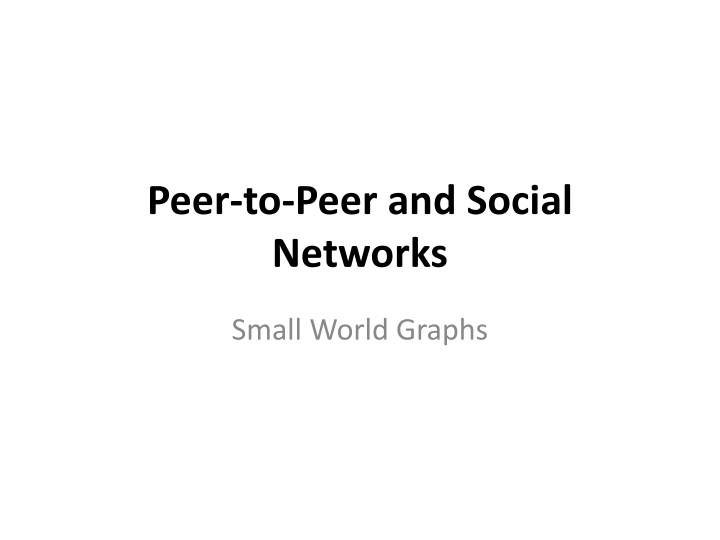
Small-World Graphs and Social Networks: Exploring Connectivity Patterns
Delve into the fascinating world of small-world graphs and social networks, understanding the reasons behind the six degrees of separation phenomenon and the properties of these interconnected systems. Discover the small-world model proposed by Watts and Strogatz and the limitations it faces in explaining network connectivity.
Download Presentation

Please find below an Image/Link to download the presentation.
The content on the website is provided AS IS for your information and personal use only. It may not be sold, licensed, or shared on other websites without obtaining consent from the author. If you encounter any issues during the download, it is possible that the publisher has removed the file from their server.
You are allowed to download the files provided on this website for personal or commercial use, subject to the condition that they are used lawfully. All files are the property of their respective owners.
The content on the website is provided AS IS for your information and personal use only. It may not be sold, licensed, or shared on other websites without obtaining consent from the author.
E N D
Presentation Transcript
Peer-to-Peer and Social Networks Small World Graphs
The small-world model [Watts and Strogatz (1998)] They followed up on Milgram s work and reason about why there is a small degree of separation between individuals in a social network. Research originally inspired by Watt s efforts to understand the synchronization of cricket chirps, which show a high degree of coordination over long ranges, as though the insects are being guided by an invisible conductor. Disease spreads faster over a small-world network.
Questions not answered by Milgram Why six degrees of separation? Any scientific reason? What properties do these social graphs have? Is clustering the only missing link? (Human beings prefer clustered environments). But the diameter must also be low! Time to reverse engineer this.
What are small-world graphs Completely regular n k >logn Small-world graphs ( ) Completely random n = number of nodes, k= number of neighbors of each node
Completely regular If then k=4 Clustering coefficient CC =36=12 Diameter L =n 2k The clustering coefficient is OK, but Diameter is too large! A ring lattice
Completely random Diameter is small, but the Clustering coefficient is too small!
Small-world graphs Start with the regular graph, and with probability p rewire each link to a randomly selected node. It results in a graph that has high clustering coefficient but low diameter
Small-world graphs Small- world properties hold
Limitation of Watts-Strogatz model Jon Kleinberg argues Watts-Strogatz small-world model illustrates the existence of short paths between pairs of nodes. But it does not give any clue about how those short paths will be discovered. A greedy search for the destination will not lead to the discovery of these short paths.
Kleinbergs Small-World Model (n n) Consider an grid. Each node has a link to every node at lattice distance q (short range neighbors) & p long range links. Choose long-range links at d-r lattice distance with a probability proportional to d (**See note below) n p = 1, q = 2 r = 2 n **Here r denotes the dimension of the space. Since we are considering a 2D grid, r=2
Results q p a0 Theorem 1.There is a constant (depending on n and , the expected r =0 but independent of ), so that when a0. n2/3 delivery time of any decentralized algorithm is at least ** The above result is valid for a 2D grid only. For a 1D space like a Linear topology of a ring, the expected time will be different
Proof of theorem 1 Probability to reach within n2/3 a lattice distance from the target is 2.n4/3 n2 = 2.n-2/3 So, it will take an expected O(n2/3) steps to reach the target.
More results a2 Theorem 2. There is a decentralized algorithm A and a constant (dependent on and ) but independent of n, such that when r=2 and , the expected delivery time of A is at most p = q =1 p q a2.log2n For a one-dimensional search space, the same result will hold for i.e the expected delivery time is O(log2n) when long-range links at distance d are chosen with probability proportional to d-1 (r=1)
Variation of search time with r This is for a 2D topology Log T Exponent r
Proof of Theorem 2 Main idea. We show that in phase j, the expected time before the current message holder has a long-range contact within lattice distance 2j from t is O(log n); at this point, phase j will come to an end. As there are at most log n phases, a bound proportional to log2n follows.
Proof of Kleinbergs theorem For simplicity we prove it for a one dimensional ring topology, so r =1 1 Z. 1 Probability (u linking to v) = d(v,u) d(u,v)=n/2 1 Z. 1 1/2 Since d(v,u) d(u,v)=1
Proof continued = 2+2lnn2 2log2n ( ) n/2 1 x Z 2 1+ .dx 1 An upper bound of the normalizing constant is the area under the curve which is Z 2logn
Proof continued Thus, probability that a link (v,w) exists is = We now calculate the time taken in one phase (implies that the distance to the target becomes less than d/2. Probability in one step the search reaches a given node in the target zone Why? Probability that in one step the search reaches some node within distance d/2
Proof continued j How can this continue? Let be the number of steps in phase Xj The probability that this phase continues for at least i steps The expected number of steps to complete phase j is = So, This leads to
Proof continued The expected number of steps for the total search E(X)= E(X1)+E(X2)+...+E(Xlogn) 3 ( ) 2 logn 2 ( ) i.e. O log2n
